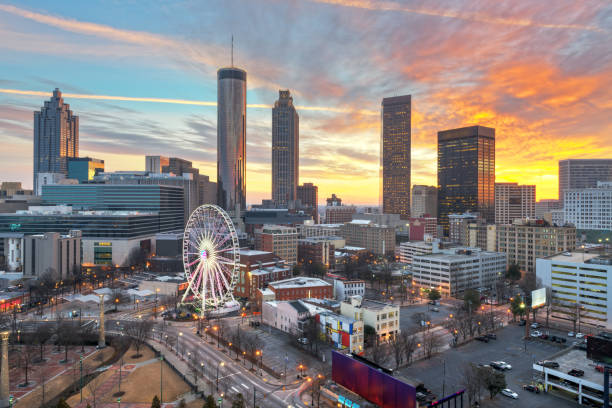Atlanta pulls you in with its peach trees, sweet tea culture, and that unmistakable Southern hospitality. The city hums with energy, from the historic streets of downtown to the modern skyline that pierces the Georgia sky. You can feel the pulse of history and progress mixing in a way that makes Atlanta unlike anywhere else.
But here’s the thing about big cities. They come with shadows alongside the shine. Some neighborhoods struggle with crime rates that make evening walks risky and car break-ins common. Your safety matters, whether you’re visiting for a weekend or considering making Atlanta home.
Knowing which areas deserve extra caution can make all the difference between a great experience and a regrettable one. Let’s walk through the spots where you’ll want to keep your guard up.

Places to Avoid in Atlanta, Georgia
Understanding the landscape of safety in Atlanta helps you make smarter choices about where to go and when. Here are ten areas where crime statistics and local reports suggest exercising heightened awareness or avoiding altogether.
1. Mechanicsville
Sitting just southwest of downtown, Mechanicsville carries the unfortunate distinction of being one of Atlanta’s most challenging neighborhoods. The violent crime rate here hits roughly 2,530 incidents per 100,000 people, which translates to a reality where residents constantly worry about their safety after sunset.
Gang activity drives much of the violence you’ll find here. Gun-related incidents aren’t rare occurrences but regular concerns that shape daily life. Auto theft and burglary happen frequently enough that parking your car feels like playing Russian roulette with your belongings.
The neighborhood’s proximity to downtown means you might accidentally wander into this area if you’re not paying attention to street signs. Many residents complain that police presence feels inadequate for the level of crime they face. If you need to pass through, do it during daylight hours and don’t linger at stop signs or red lights longer than necessary.
2. Vine City and The Bluff
These adjacent neighborhoods have earned notorious reputations that unfortunately match reality. Vine City sees violent crime rates around 261% higher than the national average, and The Bluff area has become synonymous with Atlanta’s drug trade.
What makes this area particularly problematic is the deep-rooted nature of its challenges. Drug-related crime has saturated these streets for decades. The cycle of poverty and violence feeds itself, creating an environment where criminal activity feels almost normalized.
English Avenue shares similar struggles with its neighbor Vine City. Together, they form a corridor where your personal safety becomes a serious concern. Even revitalization efforts and community initiatives haven’t managed to fully turn the tide. Property crimes run rampant alongside violent incidents, making this an area where both your belongings and your physical safety face risks.
The smart move? Route your GPS around these neighborhoods entirely. The few minutes you might save cutting through aren’t worth the potential consequences.
3. Adamsville
Tucked into the western section where I-20 and I-285 intersect, Adamsville struggles with numbers that tell a stark story. With violent crime at 2,315 incidents per 100,000 people and property crime hitting 8,084 per 100,000, this neighborhood consistently ranks among Atlanta’s most dangerous.
The economic struggles here run deep. Good-paying jobs are scarce, and the median household income sits around $30,664, well below the city average. This creates a perfect storm where desperation and opportunity collide in unfortunate ways. Home values hover around $91,000, reflecting both the area’s challenges and the reluctance of buyers to invest here.
Residents face a daily reality of watching their backs and securing their property. Break-ins occur with alarming regularity. Your car becomes a target the moment you park it. Even walking to a corner store can feel like navigating a minefield of potential threats.
4. Grove Park
Located in northwest Atlanta near Westside Reservoir Park, Grove Park presents an interesting contradiction. New development projects have sprouted up, attempting to breathe fresh life into the area. Yet crime statistics refuse to budge in the right direction.
Break-ins plague residents, particularly those living in poorly maintained apartment complexes. Many tenants report broken entry systems that might as well be welcome mats for criminals. Dark stairwells and absent security patrols create environments where assaults and robberies happen without witnesses. Vandalism damages property and morale in equal measure.
The infrastructure problems here go beyond crime itself. Broken street lighting leaves entire blocks shrouded in darkness after sunset. This isn’t just inconvenient. It’s dangerous. Criminals love shadows, and Grove Park unfortunately provides plenty of them. If you’re considering housing in this area because of lower rent prices, factor in the real cost of living somewhere you’ll constantly worry about your safety and possessions.
5. Center Hill
Center Hill earns its spot on this list through a combination of violent crime and property theft that creates an atmosphere of constant unease. The crime rate sits around 54.84 incidents per 1,000 residents annually, with property crime reaching 2,365 per 100,000 people.
What really drives home the severity here are the shooting incidents that dot the neighborhood’s recent history. A 21-year-old was killed on Bethel Drive in December 2021. An 18-year-old was shot dead outside a business strip in 2023. A double shooting near Hill Street and Center Hill Park in August 2024 left one dead and another injured. These aren’t abstract statistics. They’re lives lost and families shattered.
The estimated cost of crime in Center Hill exceeds $10 million annually, working out to roughly $942 per resident. That figure represents more than money spent on security systems and insurance claims. It reflects the toll that constant vigilance and fear take on a community. The neighborhood’s severe crime risk rating of 70% relative to other U.S. neighborhoods isn’t just a number. It’s a warning you should take seriously.
6. Adair Park
Crime in Adair Park runs about 183% higher than the national average. Violent crime specifically clocks in at 173% above what you’d find in a typical American neighborhood. These percentages translate to real risks when you’re walking down the street or parking your car.
Property crime hits particularly hard here, with rates around 37.70 per 1,000 residents each year. Theft accounts for most of these incidents at roughly 27.71 per 1,000 residents. But burglary and vehicle theft add their own layers of concern. Your locked car door offers less protection than you’d hope in an area where criminals have perfected the art of quick break-ins.
CrimeGrade assigns Adair Park a “D” rating for property crime, signaling above-average risk compared to other neighborhoods across the country. This grade reflects patterns that have persisted over time rather than temporary spikes. The neighborhood’s challenges run deep, making short-term improvements unlikely. Your best bet? Find somewhere else to explore or live.
7. West End
West End presents a tricky situation because it’s actively going through revitalization. Historic architecture lines the streets, giving the neighborhood undeniable charm. But beauty doesn’t stop bullets, and the area still grapples with serious safety issues.
Armed robberies happen with disturbing frequency, particularly near the MARTA stations that serve as transit hubs for the area. Tourists often get caught off guard here. They see the scenic buildings and historic commercial zones, assuming safety comes standard with such aesthetic appeal. Wrong assumption.
Vehicle break-ins target cars parked near shops and restaurants. Assaults occur in parking lots where businesses have failed to install adequate outdoor lighting or hire security personnel for late-hour operations. The contrast between the neighborhood’s architectural promise and its security reality creates a false sense of safety that can leave you vulnerable. If you visit West End, stick to daylight hours and crowded areas. Don’t let the pretty facades lull you into complacency.
8. Bankhead
Despite sitting close to downtown Atlanta, Bankhead struggles with issues that keep it firmly in the danger zone. Gang activity, shootings, home invasions, and carjackings form the unfortunate rhythm of daily life here. The area has battled these problems for years without finding lasting solutions.
Public investment has largely bypassed Bankhead, leaving infrastructure neglected and opportunities scarce. This lack of resources creates conditions where crime flourishes. You’ll notice the difference the moment you enter the neighborhood. Broken streetlights, abandoned properties, and a general sense of decay mark the landscape.
Carjackings deserve special mention because they’ve become increasingly common in Bankhead. These aren’t just property crimes. They involve confrontation, often at gunpoint, putting your life in immediate danger. Your expensive car makes you a target. Your hesitation at a stop sign creates an opportunity for criminals. The best approach? Don’t put yourself in a position to become a statistic.
9. Old Fourth Ward (Certain Parts)
This one requires nuance because the Old Fourth Ward has undergone significant transformation in recent years. The BeltLine runs through here, bringing development, restaurants, and foot traffic. But not every corner has benefited equally from this progress.
Certain sections, particularly those farther from the main BeltLine corridor, still experience higher crime rates than you’d want. Property crime remains an issue, with car break-ins targeting vehicles parked overnight or in less-trafficked areas. The neighborhood’s transition from rough to refined hasn’t been completed, leaving pockets where old problems persist.
The key here is location specificity. The developed parts near popular attractions generally offer reasonable safety during daytime hours. But venture too far from the gentrified zones, especially after dark, and you enter different territory. Research your exact destination if you’re headed to Old Fourth Ward. Don’t assume the whole neighborhood shares the same safety profile as its most polished sections. Ask locals, check recent crime reports, and trust your instincts when something feels off.
10. East Point (Adjacent City)
While technically a separate municipality just southwest of Atlanta proper, East Point deserves mention because it shares borders with the city and sees frequent crossover traffic. The violent crime rate here runs higher than you’d find in most Atlanta neighborhoods, creating risks for anyone passing through or visiting.
The city has worked to improve its reputation, but statistics tell a stubborn story. Crime remains elevated across multiple categories, from violent offenses to property theft. Your risk increases significantly if you’re unfamiliar with which specific areas within East Point carry the highest danger.
Many people end up in East Point without planning to visit because it sits along major routes connecting Atlanta to points south. This accidental exposure creates vulnerability. You’re not expecting trouble, so you let your guard down. Gas stations and convenience stores can become crime hotspots, particularly during evening hours. If you need to stop in East Point, choose well-lit locations with a visible security presence. Don’t stop at deserted parking lots or isolated businesses, no matter how urgent your need seems.
Wrapping Up
Atlanta offers incredible experiences, from world-class food to a rich cultural heritage. But your safety depends on knowing where caution becomes essential. These ten areas carry elevated risks that make them worth avoiding, especially if you’re unfamiliar with the city.
Smart travelers and residents do their homework. They check recent crime statistics, ask locals for current conditions, and trust their instincts when something feels wrong. Your awareness becomes your best protection.
Stick to well-traveled areas, stay alert to your surroundings, and don’t let curiosity lead you into neighborhoods where crime statistics speak louder than any tour guide.


